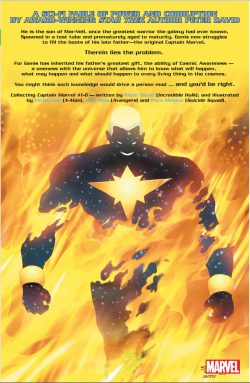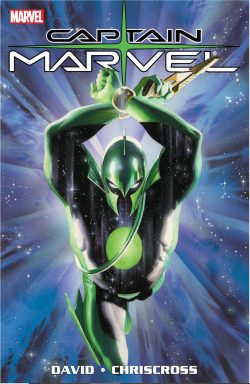

By Peter David, ChrisCross, Ivan Reis, Paco Medina & various (Marvel Comics)
ISBN 978-0-7851-1104-7 (TPB/Digital edition)
Once upon a time, individuality was king and identity constantly – and litigiously – defended. These days, superhero comics are filled with spin-offs, legacies and alternates. Where once DC eradicated an entire multiverse to ensure readers would see there was only one Superman, Batman or Wonder Woman now there are dozens of iterations of every costumed character and fans couldn’t be happier.
However, there was always one title/character that bucked the trend…
One of the most venerated, beloved characters in American comics was created by Bill Parker & Charles Clarence Beck as part of the wave of opportunistic creativity following the successful launch of Superman in 1938. Although there were many similarities in the early years, the Fawcett Comics character moved swiftly and solidly into realms of light entertainment and even broad comedy, whilst throughout the 1940s the Man of Steel increasingly sidelined whimsy in favour of family-friendly action and drama.
Homeless orphan and thoroughly good kid Billy Batson was selected by an ancient wizard to battle injustice and subsequently granted the powers of six gods and mythical heroes. By speaking aloud the wizard’s name – an acronym for divine patrons Solomon, Hercules, Atlas, Zeus, Achilles and Mercury – he transformed from scrawny boy to brawny (adult) champion Captain Marvel.
At the height of his popularity, “the Big Red Cheese” was published twice monthly, hugely outselling Superman, and in 1941 DC/National Comics launched an infamous court case citing copyright infringement. However, as the decade progressed and tastes changed, sales slowed, and the case was settled just as many publishers started switching from costumed heroes to “Real Men” and monsters. Like many superheroes, Captain Marvel and his gods-powered kin disappeared, becoming a fond memory for older fans. A big syndication success, he was missed all over the world. In Britain, where an English reprint line had run for many years, creator/publisher Mick Anglo had an avid audience and no product, and so transformed the Captain and company into atomic age heroes Marvelman, Young Marvelman and Kid Marvelman continuing to thrill readers into the early 1960s, even if here there were no girls allowed.
Then, as America lived through another superhero boom-&-bust, the 1970s dawned with a shrinking industry and wide variety of comics genres servicing a base that was increasingly founded on collectors and fans rather than casual or impulse buyers. National/DC Comics needed sales and were prepared to look for them in unusual places.
After the court settlement with Fawcett in 1953 they had secured the rights to Captain Marvel, Captain Marvel Junior, Mary Marvel and all the spin-off Family. Now, even though the name itself had been taken up by Marvel Comics (via a circuitous and quirky robotic character published by Carl Burgos and M.F. Publications in 1967), the publishing monolith decided to tap into that discriminating if aging fanbase.
In 1973, riding a wave of national nostalgia on TV and in movies, DC brought back the entire beloved Marvel crew in their own kinder, weirder universe. To circumvent the intellectual property clash, they named the new title Shazam! (…With One Magic Word!) – the trigger phrase used by myriad Marvels to transform to and from mortal form, and a word that had entered the American language due to the success of the franchise the first time around.
Meanwhile, at the other place…
In 1968, upstart Marvel was in the ascendant. Their sales were rapidly overtaking industry leaders National/DC and Gold Key Comics and, having secured a new distributor allowing them to expand their list of titles exponentially, the company was about to undertake a creative expansion of unparalleled proportions.
Once individual stars of “split-books” Tales of Suspense, Tales to Astonish and Strange Tales were awarded their own titles, the House of Ideas just kept on going. In progress was a publishing plan seeking to take conceptual possession of the word “Marvel” through both reprint series such as Marvel Tales, Marvel Collector’s Items Classics and Marvel Super-Heroes. Eventually, showcase titles such as Marvel Premiere, Marvel Spotlight and Marvel Feature also proudly trumpeted the name, so another dead-cert idea was to have an actual hero named for the company – and preferably one with some ready-made cachet and pedigree as well.
After the infamous 1940s-1950s copyright case of the, the prestigious appellation Captain Marvel disappeared from newsstands. In 1967, during the “Camp” craze/superhero boom generated by the Batman TV series, publisher MLF produced a number of giant-sized comics featuring an intelligent robot able to divide his body into segments and shoot lasers from his eyes. Their legal right to have done so is still disputed…
Quirky, charming and devised by Carl Burgos (creator of the Golden Age Human Torch), the series failed to attract a large following in that flamboyantly flooded marketplace and on its demise the name was snapped up by Marvel Comics Group who properly secured rights to the name and have defended it ever since by publishing numerous characters who all seemed doomed to high quality runs and early cancelation…
In 1968, Marvel Super-Heroes was a brand new title: reconfigured from extended-length reprint vehicle Fantasy Masterpieces, which mixed vintage monster-mystery tales with Golden Age Timely Comics classics. With the 12th issue it added a try-out section for characters without homes. These included the Inhuman Medusa, Ka-Zar, Black Knight and Doctor Doom, plus new concepts Guardians of the Galaxy and Phantom Eagle, in all-new stories.
They kicked off with an alien spy sent to Earth from the Kree Galaxy. He held a Captain’s rank and his name was Mar-Vell. After two appearances, Captain Marvel catapulted straight into his own title for a rather hit-and-miss career combatting spies, aliens and costumed cut-ups like Sub-Mariner, Mad Thinker and Iron Man. Most frequently, however, he clashed with elements of his own rapaciously colonialist race – such as imperial investigative powerhouse Ronan the Accuser – all while slowly switching allegiances from the militaristic Kree to the noble, freedom-loving denizens of Earth.
This particular incarnation of the “trademark-that-must-not-die” features the son of that Kree warrior and long-time company supporting character/professional sidekick Rick Jones in a symbiotic relationship echoing the heyday of Mar-Vell’s flower-power glory days. Fair warning though, despite the excellent writing and great art, if you are not at least passingly familiar with Marvel’s close continuity, this is not a series of books you want to read without a little preparation.
Scripted by Peter David, with colours by Chris Sotomayor and letters from RS (Richard Starkings) & Comiccraft’s Albert!, Nothing to Lose collects Captain Marvel volume 2 #1-6 (cover-dates November 2002-April 2003, and I said it was confusing didn’t I?). It expands the saga of Genis, an artificially-matured test-tube baby son of Mar-Vell.
The Kree warrior turned Cosmic Protector saved Earth and Universe countless times before dying of cancer in the landmark Death of Captain Marvel (the company’s first official Graphic Novel), and here, after years trying to live up to and surpass his father’s achievements – he even debuted using the codename “Legacy” – the pressure starts to show.
Genis sought to emulate his father as a galaxy-spanning crusader, with mixed results, before hooking up with Rick Jones – his Dad’s original sidekick and, for a time, lifeline to reality. The human offered the promise of insider insights into what made him such a hero…
When Nothing to Lose opens with ‘Shards’ – illustrated by ChrisCross – he is, in fact, in just the same situation his father endured with the teen-aged Jones back in 1960’s. Their bodies are linked by “Nega-bands” – fantastically powerful alien wrist-bands which both wear, but only in turns, as they have the drawback of merging their molecular structure. This means only one body can inhabit the positive-matter universe at once, whilst the other is trapped in sub-atomic pocket-reality The Microverse. From there, the captive can observe and communicate, but not affect the “real” world.
The new Captain Marvel possesses his father’s greatest power, “Cosmic Awareness”: an ability to discern everything happening everywhere at once. Sadly, and inevitably, the gift is turning Genis into a raving madman. Just knowing something bad is happening doesn’t mean that the only solution you can offer is ultimately the right one for the universe. With so much to do, the captain has not allowed Rick to return to Earth for months…
This situation is tragically demonstrated when Marvel stops a suicide bomber from detonating on a crowded bus, only to see her murdered by one of her intended victims. His every action forces him to make immediate decisions and choose who to help for the greater good, but every choice seems to lead to unknowable cosmic consequences. This hopeless situation is repeated, magnified and drastically clarified after his intervention in an Badoon invasion and other missions.
As days pass Rick faces the fact that his partner’s omniscience and growing clairvoyance is more curse than blessing, and an increasing capriciousness is affecting Captain Marvel’s compulsion to “Do Good”. ‘Shock Absorber’ see Jones explore his options by going on an arduous pilgrimage and consulting (relatively) local god Shinga Doon, whilst the cosmic avenger starts taking advice and moral instruction from the Punisher…
In ‘Pamavision’ Genis joins the militaristic Kree’s colonial space fleet as they invade and colonise strategic world Toped: meeting the man who trained his father, embracing the bellicose expansionist culture and rising fast in the ranks. In the Microverse, Rick is unexpectedly joined by another truth-seeker just as his guru meets a sudden and mysterious death…
The Toped campaign goes badly wrong for the Kree in ‘Uriah’ (rendered by Ivan Reis) as the Captain uncovers sedition, ambition and espionage run wild, whilst Rick learns his fellow stranded acolyte – Epiphany – is far more than she seems. When war with the Shi’ar looms and romantic intrigue runs riot, Marvel’s solution is to kill everybody and then himself…
ChrisCross returns for ‘Au Pere’ as a truly brutal father & son moment in the great beyond leads to Genis discovering that both he and Rick have been manipulated by trans-cosmic siblings Epiphany and Entropy with a view to ousting the current supervisor of reality.
They have done their work well and deranged Genis eagerly anticipates battling the universe’s most powerful conceptual entities, killing Supreme Being Eternity and ending painful reality well before its due date…
Happily for all, Rick hasn’t given up hope in the spectacular and awe-inspiring Paco Medina-limned closing chapter ‘Four Characters in Search of Creation’…
This slim tome includes covers and variants by Alex Ross, CrissCross, Joe Jusko, Kia Asamiya, Phil Noto, JG Jones and Andy Kubert as well as an ‘Alex Ross Captain Marvel Concept Artwork’ feature, sharing his design process and thoughts on the character’s powerful reworking.
Wry, sardonic, explosively action-packed and sublimely provocative, Peter David’s blackly tongue-in-cheek examination of power and perspective has some truly chilling moments, and has a lot to say on the nature of heroism, all leavened by his absurdist sensibilities and love of comedy word-play. His take on duty and honour is wickedly engaging, with the sumptuous art carrying the sneaky double-dealing and savage conflicts with ease.
© 2021 MARVEL.
